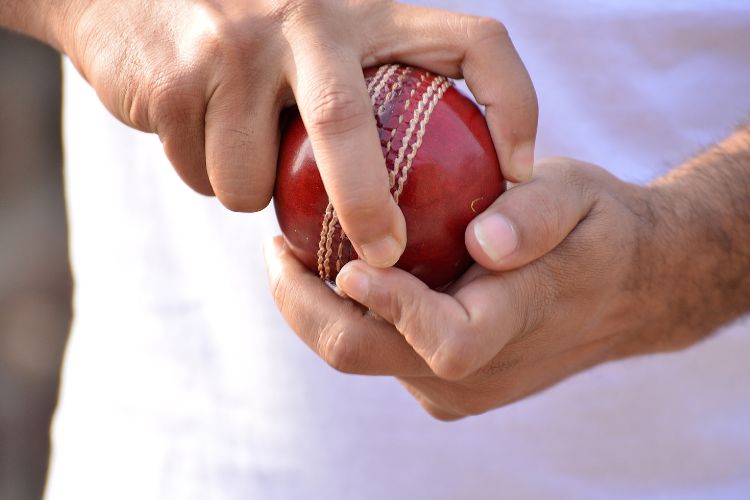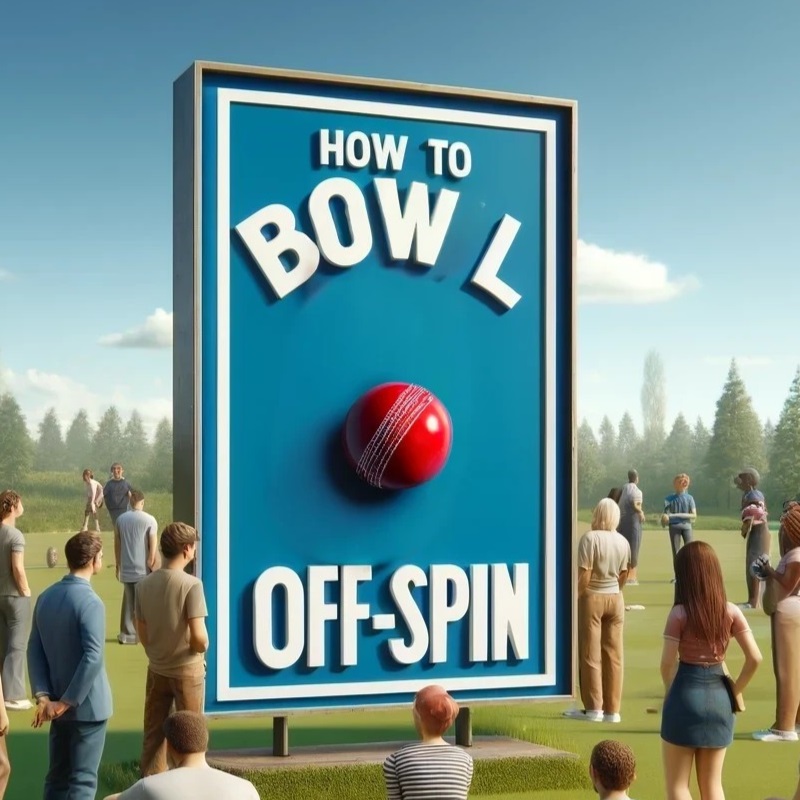In previous posts we’ve talked about the fast bowler’s repertoire, from outswing to inswing, slower balls and reverse swing.
Now, we’re slowing things right down, and talking about spin bowling, and, in particular for this post, off-spin. In the next post, we’ll talk about some of the variations that an off-spinner should learn.
Off-spin is simply a ball that turns from the off-side to the leg side. Technically, the direction this spin takes is in relation to the bowler, so for a right-hand bowler, the ball will spin from left to right, and for a left-hand bowler, the ball will spin from right to left.
The essence of off-spin bowling lies in its subtlety and guile. Unlike fast bowlers who rely on speed and bounce, off-spinners depend on precision, variations, and the ability to read the batter’s intentions.
They often operate in tandem with field settings that create pressure, forcing batters into errors. The role of an off-spinner is not just to take wickets but also to build pressure and create opportunities for other bowlers.
Variations are a vital part of an off-spinner’s arsenal. A skilled off-spinner can bowl the conventional off-spin delivery, but the real mastery lies in the ability to bowl different variations with the same action.
These variations include the arm ball, and the top-spinner, but may also include more advanced deliveries like the doosra, the carrom ball, and others. An off-spinner should always be working on improving their craft, and may find different ways to bamboozle the batter that other bowlers have yet to discover.
It is not rare for a spinner, whether off or leg, to say they have come up with a number of new types of spinning delivery. And sometimes, just the mere mention that an spinner has a new ball plays in the batter’s mind and makes them doubt, even if there is no actual proof of that new ball ever being bowled.
This is because a large part of any spinner’s game, whether off-spinner or leg, happens between the ears … either theirs or the batter’s … and usually both.
In the following sections, we’ll be explaining how to bowl the stock-standard off spinner, and in the next post, we’ll talk about some of the variations. We’ll be offering insights and tips to help you enhance your skills and effectiveness on the field.
Mastering the Basics of Off-Spin
Grip
Off-spin bowling, a staple in the arsenal of any cricket team, hinges on mastering the basics. One of the fundamental aspects to focus on is the proper grip.
Different off spinners have different grips, so you will need to figure out which one works best for you. What grip you use will likely depend on the size of your hand.
For a standard off-spin delivery, grip the ball with the tip of your index finger perpendicular to the seam, with the tip of your finger touching the seam. Now, depending on the size of your hand or how comfortable it feels in your hand, either put your middle or ring finger on the other side of the ball, tip of the finger touching the seam.
If this is your ring finger, then your middle finger should be placed, not surprisingly, in the middle, again the tip touching the seam.
Some bowlers have that first finger tip touching the seam, others have their first finger bent and their top knuckle touching the seam. Again, you should practice and use whatever works best for you.
Your thumb should be used to support the ball, but the majority of the force on the ball will be your index and middle/ring fingers. The remaining finger/s – this might be just your pinkie, or your pinkie and ring finger, are tucked away.
Approach
The approach is crucial for building momentum and setting up the delivery. It should be a comfortable, measured run-up that allows you to maintain balance and rhythm. You should focus on a consistent approach that is neither too fast nor too slow, providing a solid base for the delivery stride.
Delivery
During the delivery stride, you should plant the front foot firmly on the ground, slightly across your body, which helps in creating an angle and maintaining balance. Your bowling arm should come over the shoulder with the wrist positioned to release the ball with your fingers rolling over the seam, imparting the spin. Try to ensure the seam is at 45 degrees, pointed towards leg slip, and remains like that after the ball is bowled.
Follow Through
The follow-through is vital for maintaining balance and control. After releasing the ball, you should continue the motion naturally, allowing your body to complete the action. This helps in ensuring that the delivery is smooth and prevents injuries. The follow-through should end with you facing the batter, ready to field the ball if necessary.
Working on the Traditional Off-Break
The key to a successful off-break lies in the wrist’s motion and the fingers’ snap at the point of release. Your fingers should roll over the seam, imparting a clockwise (for a right hander) spin to the ball as it heads towards the batter.
Bowlers often encounter common errors that can dilute the effectiveness of their off-breaks. One frequent mistake is not completing the follow-through. This error usually leads to reduced spin and can make the delivery easier to play.
Another common issue is inconsistent release points, which affect the ball’s trajectory and make it difficult to maintain a challenging line and length. You need to focus on a consistent release point and a complete arm rotation during the delivery to enhance accuracy and spin.
To enhance the spin and control on the cricket ball, you can work on strengthening your fingers and wrists, which are crucial in generating more revolutions on the ball. This can be achieved through specific exercises aimed at enhancing wrist flexibility and finger strength.
Additionally, practicing with a slightly older ball can help you get accustomed to extracting spin on less responsive surfaces, further improving your control.
The Art of Speed and Flight in Off-Spin Bowling

There are different variations of the off-spin grip. This one has their fingers beyond the seam.
In off-spin bowling, mastering the variations in speed and the flight of the ball can significantly elevate a bowler’s game, creating doubts and hesitation in the batter’s mind.
Flight Variations
The flight of a ball in cricket refers to its trajectory through the air before it pitches. An off-spinner who can skilfully vary the flight of the ball can play mind games with a batter.
Delivering a ball with a higher, looping flight might tempt the batter into stepping out of the crease, aiming for an aggressive shot, potentially leading to a stumping or a catch if the ball spins more or less than expected.
Similarly, a subtly flatter trajectory can rush the batter, leading to a mistimed shot or an edge.
Slower vs Faster
Slower deliveries are particularly effective in conditions where the pitch offers more grip and turn. These deliveries have more time in the air to deviate and deceive the batter in flight.
On a slower pitch, such deliveries can grip the surface better, leading to increased spin and bounce, thereby enhancing the ball’s unpredictability. Slower balls are advantageous when the batter is looking to attack, as the change in pace can cause them to play the shot too early and mishit the ball.
Conversely, faster deliveries have their place, especially when the pitch is flatter or when the batter is less aggressive.
A quicker, flatter trajectory reduces the batter’s time to react and adjust, making it a useful tool for rushing them or pinning them on the back foot. This is particularly effective against batters who prefer to step out or are adept at cutting and pulling since the reduced time makes such shots riskier.
Off-spin bowlers must adapt their speed and flight according to varying pitch conditions. On a dry, dusty pitch, more flight and slower speeds can exploit the surface’s natural variation.
On harder, greener pitches, a quicker, flatter trajectory might be more effective, limiting the batter’s shot options and targeting the stumps or pads more directly.
To refine control over these aspects, you can practice specific drills.
One effective drill is to place a marker on the pitch at different lengths and practice hitting it with both flighted and flat trajectories at varying speeds.
Another drill involves bowling with a single stump as the target, focusing on line and length, regardless of speed or flight.
Additionally, you can practice with a batter in the nets, trying different speeds and flights to see what works best against different styles of batting.
Last Word On Off Spin Bowling
Technically, this isn’t the last word on off-spin bowling. Instead, we’ll use the last words to urge you to come back again to read the next post regarding some of the different variations an off-spin bowler can learn.
Who is the greatest off-spin bowler you have seen? Or what was the greatest off-spin delivery you can remember? Please comment with some of your best memories of off-spin and off-spin bowlers.

